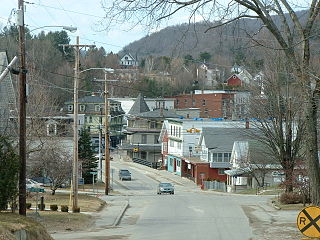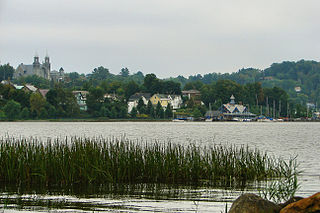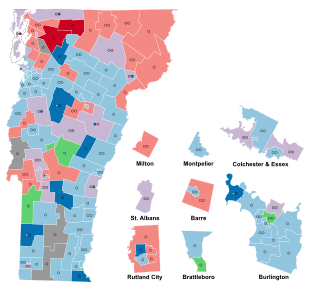
Orleans County is a county located in the northeastern part of the U.S. state of Vermont. As of the 2020 census, the population was 27,393. Its shire town is the city of Newport. The county was created in 1792 and organized in 1799. As in the rest of New England, few governmental powers have been granted to the county. The county is an expedient way of grouping and distributing state-controlled governmental services.

Essex County is a county located in the northeastern part of the U.S. state of Vermont. As of the 2020 census, the population was 5,920, making it the least-populous county in both Vermont and New England. Its shire town is the municipality of Guildhall. The county was created in 1792 and organized in 1800. Bordered by the Connecticut River next to New Hampshire, Essex County is south of the Canadian province of Quebec. It is the county with the lowest household-income in Vermont.

Caledonia County is a county located in the northeastern part of the U.S. state of Vermont. As of the 2020 census, the population was 30,233. Its shire town is the town of St. Johnsbury. The county was created in 1792 and organized in 1796. It was given the Latin name for Scotland, in honor of the many settlers who claimed ancestry there.

Hardwick is a town in Caledonia County, Vermont, United States. The population was 2,920 at the 2020 census. It contains the unincorporated villages of Hardwick, East Hardwick, and Mackville. The town is a commercial center for the region's farming population.

Coventry is a town in Orleans County, Vermont, United States. The population was 1,100 at the 2020 census.

Glover is a town in Orleans County, Vermont, in the United States. As of the 2020 census, the town's population was 1,114. It contains two unincorporated villages, Glover and West Glover.

Lowell is the westernmost town in Orleans County, Vermont, United States. The population was 887 at the 2020 census.
Orleans is a village in the northwestern corner of Barton, Orleans County, Vermont, United States. With a population of 788 at the 2020 census, it is the largest village in the county.

Barton is a village located near the center of the town of Barton, in Orleans County, Vermont, United States. The population was 690 at the 2020 census.

Barton is a town in Orleans County, Vermont, United States. The population was 2,872 at the 2020 census. The town includes two incorporated villages, Barton and Orleans. Approximately a quarter of the town's population lives in each of the villages, and approximately half lives outside the villages. Only four other towns in the state contain two incorporated villages.

Newport is the only city in, and the shire town of, Orleans County, Vermont, United States. As of the 2020 Census, the population was 4,455. The city contains the second-largest population of any municipality in the county, and has the smallest geographic area. It is the second-smallest city by population in Vermont. Newport is also the name of neighboring Newport Town.
The Northeast Kingdom is the northeast corner of the U.S. state of Vermont, approximately comprising Essex, Orleans, and Caledonia counties and with a population of 64,764 at the 2010 census. The term "Northeast Kingdom" is attributed to George D. Aiken, former Governor of Vermont and a U.S. senator, who first used the term in a 1949 speech.
The Grand Isle-Chittenden-1-1 Representative District is a two-member state Representative district in the U.S. state of Vermont. It is one of the 108 one or two member districts into which the state was divided by the redistricting and reapportionment plan developed by the Vermont General Assembly following the 2000 U.S. Census. The plan applies to legislatures elected in 2002, 2004, 2006, 2008, and 2010. A new plan will be developed in 2012 following the 2010 U.S. Census.
Lake Region Union High School, commonly known as Lake Region, is a secondary school located in Barton, in the U.S. state of Vermont. The school is operated by the Orleans Central Supervisory Union school district.
The North Country Supervisory Union is a school district responsible for the education of students in the Vermont towns of the city of Newport, Newport Town, Derby, Charleston, Jay, Troy, North Troy, Coventry, Brighton, Holland, Morgan, Westfield, and Lowell. It is administered by a school board.

The 2000 United States presidential election in Vermont took place on November 7, 2000, and was part of the 2000 United States presidential election. Voters chose three representatives, or electors to the Electoral College, who voted for president and vice president.

In 2021, Wind power in Vermont consisted of five utility-scale wind farms with a total capacity of 149 megawatts (MW). They were responsible for one-sixth of in-state electricity generation in 2019.
Vermont electric power needs are served by over twenty utilities. The largest is Green Mountain Power, a subsidiary of Énergir which recently also took over Central Vermont Public Service. Together this single company represents 70% of the retail customers in Vermont. The state is a small electricity consumer compared with other states. Therefore, its electricity sector has the lowest carbon footprint in the country. As of 2010, the state had the lowest wholesale electricity costs in New England. Efficiency Vermont engages in aggressive initiatives to cut residential electricity waste, which often identifies other problems that it claims can save hundreds per household per year. Accordingly, Vermont's overall energy bills are also relatively lower than in the rest of the New England states.

The 2018 Vermont House of Representatives elections took place as part of the biennial United States elections. Vermont voters will elect state representatives in all 150 seats. State representatives serve two-year terms in the Vermont House of Representatives. A primary election on August 14, 2018, determined which candidates appeared on the November 6 general election ballot.













